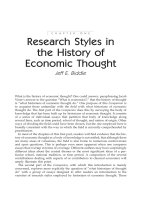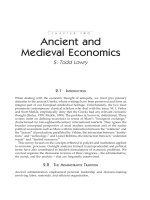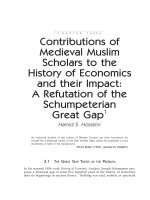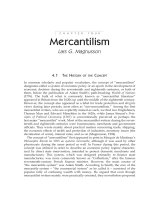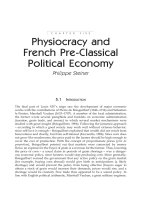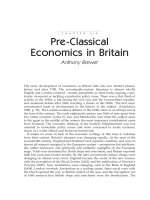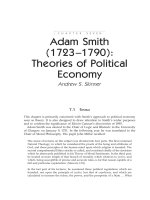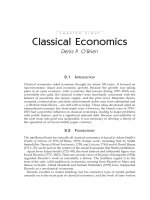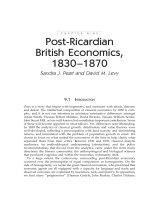A Companion to the History of Economic Thought - Chapter 2 ppt
Bạn đang xem bản rút gọn của tài liệu. Xem và tải ngay bản đầy đủ của tài liệu tại đây (213.66 KB, 17 trang )
ANCIENT AND MEDIEVAL ECONOMICS 11
CHAPTER TWO
Ancient and
Medieval Economics
S. Todd Lowry
2.1 INTRODUCTION
When dealing with the economic thought of antiquity, we must give primary
attention to the ancient Greeks, whose writings have been preserved and form an
integral part of our European intellectual heritage. Unfortunately, the two most
prominent contemporary classical scholars who deal with the issue, M. I. Finley
and Scott Meikle, emphatically deny that the Greeks had any relevant economic
thought (Finley, 1970; Meikle, 1995). The problem is, however, definitional. These
writers insist on defining economics in terms of Marx’s “bourgeois exchange,”
characterized by late-eighteenth-century international markets. They ignore the
broader conceptual perspective of most modern economists and of the earlier
political economists such as Marx with his interaction between the “relations” and
the “factors” of production; paralleled by Veblen, the interaction between “institu-
tions” and “technology,” and Lionel Robbins, the interaction between “unlimited
wants” and “limited resources.”
This survey focuses on the concepts reflected in policies and institutions applied
to economic processes. Outright analyses framed in jurisprudential and political
terms have also contributed to modern formulations of economic problems. We
can best organize the discussion in terms of three categories – the administrative,
the moral, and the analytic – that are frequently intertwined.
2.2 THE ADMINISTRATIVE TRADITION
Ancient administration emphasized personal leadership and decision-making
involving labor, materials, and efficient organization.
12 S. T. LOWRY
In retrospect, the best evidence shows that primitive human beings and their
hominid ancestors evolved in East Africa as hunter–gatherers in simple extended
family groups. In such a system, anthropological studies indicate that social bond-
ing and informal leadership roles provided the organizational cohesion necessary
for survival (Reader, 1998 [1997]).
The first records of formal economic organization and accompanying intel-
lectual frameworks come from the ancient river basin economies where grain
was produced in coordination with the annual flooding that left raw mudflats as
a seedbed. In the Nile and Euphrates Valleys, high yields and dry conditions for
storage resulted in stable populations that required land measurement (geometry)
and public regulation. The population concentrations and cultural accumula-
tion made possible by this form of agriculture are reflected in the Old Testament
account of Joseph, in the role of an economic advisor, administering the storage
of surplus grain to withstand future famines (Paris, 1998).
Egyptian literature documents the annual accounting of keepers of the royal
granaries, whose inventory was measured with giant scales that acquired the
status of symbols of justice. Note that the “scales of justice” were an administrat-
ive tool for annual accounting, achieving a role as a religious symbol, not as a
symbol of exchange (Brandon, 1969).
In the Euphrates Valley, some recently studied clay tablets dating from about
2,200–2,100 B.C. give a clear picture of the administrative thought and practices
of a Sumerian city–state. The Erlenmeyer Tablets, which became available for study
in 1988, constitute a collection of 88 tablets found in a large jar. These tablets
provide a set of written records of production for a three-year period (Nissen
et al., 1994). The records show yields from about 75,000 acres, with target amounts
and shortfalls in yield from year to year. Average yields were about 12.5 bushels
per acre, with three-quarters of a bushel retained for seed (6 percent!).
In addition, records for a milling operation show grain and labor inputs, with
product valued in “female labor days.” The shortfall from the target efficiency
for one year was carried over as a deficit to the next year and was measured at
7,420 female labor days (Nissen et al., 1994, p. 54).
These records show the precision of administrative organization and the origins
of both writing and arithmetic for identifying stored produce and its quantity.
Marx called this administrative tradition that dominated Near Eastern economic
organization “the Asiatic mode of production”(Krader, 1975). Silver, who searches
for expressions of natural market forces, finds that political and economic instab-
ilities resulted in nonmarket institutions dominating the economies of antiquity
(Silver, 1995).
Most important are these mathematical, graphic, and administrative skills
that passed from the Sumerians to the Babylonian culture, whose sexigesimal
system has influenced modern measurement of degrees, minutes, and seconds
(Nugebauer, 1969). This administrative and mathematically sophisticated tradi-
tion continued in the Near East into the Islamic culture. Note that since adminis-
tration and mathematical procedures are products of human understanding and
policy, they are clear repositories of the level of economic thought. Note as well
that the development of the zero, or cipher, was irrelevant to arithmetic as long
ANCIENT AND MEDIEVAL ECONOMICS 13
as a placement system with columns was used, crystallized in the abacus or
counting board. The zero only became important in Europe when northern African
Arabic arithmetic and bookkeeping were brought into northern Italy from Algiers
by Leonardo of Pisa (Fibonacci) in the early thirteenth century. When cumulative
written records were kept, Roman numerals proved too cumbersome for running
accounts in neat columns. It has also been argued that increasingly varied Arabic
commerce led to the development of algebra and gave rise to the mechanistic
generalization of economic processes in the late Middle Ages (Hadden, 1994). In
addition, the thirteenth century saw the shift from tally sticks to account books,
and from the itinerant trader to the sedentary merchant who used credit instru-
ments such as bills of exchange.
The best record of the tradition of training in administrative economics is
found in Xenophon’s treatise, the Oeconomicus, written in the mid-fourth century
B.C. (Pomeroy, 1994). He also draws on the Babylonian and Persian tradition
in his biography of Cyrus the Great, the Cyropaedia, that emphasizes the training
of Cyrus for administration and military leadership. Xenophon’s Hiero con-
tains discussions of the administrative stimulus of private production and tech-
nology through public recognition and prizes. His Ways and Means was a treatise
on economic development, emphasizing economies of scale, programming, and
promotion. The Oeconomicus is a systematic treatment of the organization and
administration of the agricultural estate, emphasizing human capital and organ-
izational efficiency (Lowry, 1965; 1987, ch. 3). The family farm was the backbone
of the economy and booty from military operations was the prime source of sur-
plus for farm and city (Hanson, 1995). The details of many of Xenophon’s ideas
must be treated under the heading of analysis.
The tradition of an efficiently managed agrarian estate surfaced in the twelfth
century in the Cistercian monasteries that spread across Europe. This order,
initiated in 1084 and dedicated to prayer and work, specialized in developing
new land with a rational integration of crafts and agriculture (Baeck, 1994, ch. V).
Baeck documents some indications of Muslim correlations with the Cistercian
movement through Spanish Islam. The managerial uniqueness of the Cistercians
might well be studied along with E. E. Cohen’s work on Athenian banking to
question Polanyi’s thesis that early economic activities were “embedded” in broader
social structures, and not in dominant forces (Cohen, 1992).
Plato’s contribution to administration acquires significance because he incor-
porated the Pythagorean mathematical tradition into a near-mystical formulation
of ideal models. This view of a rational perfectible administration is elaborated
below in the discussion of analysis. The Platonic theory of the “Ideas,” clearly
expounded in Adam Smith’s inaugural lecture for his professorship in logic at
Glasgow (The History of the Ancient Logics and Metaphysics) has its parallels in
modern economic theory. Plato’s theoretical perspective produced the concept of
a perfectible efficient state directed toward optimality through specialization
and training. His concept of “justice” was colored by his premise of order and
efficiency supervised by the prime intellect with a single value criterion. His fam-
ous image of the “ship of state” directed by the technically skilled pilot or captain
(the philosopher king) was properly questioned by one authority, who pointed
14 S. T. LOWRY
out that some of the passengers might want to have some influence on where
they were going (Lowry, 1987, pp. 111–14).
The concept of plural values introduced a dynamic into political economy.
When irrational numbers were demonstrated in the Pythagorean societies in the
late fifth or early fourth century B.C., Platonic absolutism was shaken to the core.
It was partially salvaged by Eudoxus’ importation from Chaldea of a dialectical
approach to irrationals that became a mathematical image for judicial, legislative,
and bargaining processes, to be discussed under analyses.
The pseudo-Platonic dialogue Alcibiades Major (ca. 340 B.C.) discusses the need
for formal training of those who presume to be “politicos” or “oikonomicos”;
that is, politicians or economists in the city–state. This document influenced the
Greco-Roman educational tradition for 900 years. The dialogue emphasizes Plato’s
concept of individualistic authoritarian virtue, but it also discusses an apparently
broader tradition that prescribed “looking into the eyes of others” to get a reflec-
tion or social criterion for managing one’s conduct as administrator. The concept
became known as “the mirror for princes,” naming a rich body of literature on
political and economic administration (Lowry, 2001). A famous example was the
Arabic pseudo-Aristotelian advice to Alexander the Great, the Secretum Secretorum,
dating from the eighth century A.D. It reached England in Latin translation after
the Crusades. Erasmus’s The Education of a Christian Prince, dedicated to the young
Emperor Charles V in 1518, was also an influential example of the genre (Born,
1936). These tracts emphasized leadership, human capital, personnel policy, taxa-
tion, trade, and control of the military.
2.3 THE MORAL TRADITION
The Eden story in Genesis provides basic imagery in the Judeo-Christian tradi-
tion. As with most cultural myths, it is a collage of concepts, including a parallel
with the female blame tradition of the Greek Pandora myth (Norris, 1999). The
dominant thesis is, however, the challenge to divine authority by the beneficiaries
of the abundance of the Garden of Eden. When Adam and Eve ate the forbidden
fruit of the tree of knowledge and asserted the right to choose for themselves,
they were cast out of the world of abundance into scarcity; to “eat bread in the
sweat of their faces.” The moral theme is that knowledge and the exercise of
choice are burdens in a world of divinely imposed or natural scarcity. This pic-
ture of economics is usually found in the introductory chapter of sophisticated
introductory economics textbooks, although contradicted by subjective relativ-
ism in later chapters. An unfortunate spinoff of the Eden story is the “curse of
work” with its simplistic tension between work and leisure, in a world in which
most people find fulfillment and self-definition in their work.
In contrast to the bounty of the Nile and Euphrates, the near-subsistence level
in the small agrarian communities in Greece gave rise to a moral emphasis on
allocation that is the real issue behind the more superficial concept of objective
scarcity. Aristotle framed this issue very carefully in book I of his Politics. Con-
sumption was the objective of production and the surplus should be allocated to
ANCIENT AND MEDIEVAL ECONOMICS 15
rearing children (Lowry, 1995). Aristotle found this natural moral commitment
illustrated by the yolk in eggs that sustained the embryo. This was a real issue in
eastern Mediterranean societies, where newborns were not named until the eighth
day, when the family patriarch evaluated sex, health, and food supply before
ceremonially accepting them into the family circle. Unwanted children were set
adrift in baskets or left on the mountainside.
Exchange within the village and the use of money facilitated distribution, but
satiation provided a natural limit on consumption that left surpluses for the
“offspring.” By contrast, foreign merchants who accumulated money were not
subject to this natural limit of physical satiation. Therefore, this kind of trade fell
outside the natural regulatory process.
In book VII of the Politics, Aristotle clearly formulated the concept of diminish-
ing marginal utility and an ordinal hierarchy of values, an influential conceptual
framework that has been attributed to Maslow in contemporary motivation theory
(Maslow, 1943; Lowry, 1998, p. 32).
The importance of Aristotle’s distinction is its basis for the moral repudiation
of usury, in which money loans are condemned as immoral and extortionate. As
in Judaic doctrine, money cannot breed, and should not be expected to grow
when a consumption loan is made to a needy person within the community.
The moral validity of a claim for subsistence grew into a natural right of appro-
priation in the writings of Thomas Aquinas and John Locke (Lowry, 1995). In
addition, the usury issue is largely a retrospective emphasis. Medieval Muslims
developed the justification for charging borrowers for the sacrifice suffered by
the lender, adopted by Scholastics as “lucrum cessans.” The moral issue persisted
when considering the extortion implicit in subsistence loans to the starving. In
commerce, however, the institution of the commendam partnership demonstrates
the irrelevance of the usury issue and the sharing of surpluses generated by
capital advances for trade. The “commendam” was a commercial partnership in
which one party advanced the capital for a trading venture and the other pro-
vided the personal service. As in modern partnership law, profits were divided
equally between the partners after the voyage. The commendam contract, of
Arabian origin, neutralized the usury issue in commerce through the Middle Ages.
It also provided a mechanism for limiting liability to achieve economies of scale –
a device that fueled the development of the modern corporation. Several persons
could invest money in a commendam partnership with a broker, who would
then advance the sum to a trader in another commendam partnership. The initial
investors were insulated from personal liability for losses beyond their specific
investment (Udovitch, 1970).
The moral reinforcement of this system was provided by the “unwritten
law,” an ancient Near Eastern custom that guaranteed hospitality to strangers,
the honoring of parents, and respect for gods (Lowry, 1987, pp. 142–3). In his
Memorabilia (IV, 4, 19–20), Xenophon argues that the unwritten law must have
come from the gods, since it was universal among all peoples, who could not
have met together and agreed on it. The point emphasizes that the rule of hos-
pitality made merchant travelers safe and gave people a source of news, trade
goods, and entertainment provided by itinerant bards. It supported the institution
16 S. T. LOWRY
of “guest friendship” that served to initiate exchange through reciprocal gift-
giving (Lowry, l987, pp. 147–9). Through the Middle Ages, much trade was sup-
ported by special relationships between commercial families, with long traditions
reminiscent of the ancient “guest friendship” relationship.
It is important to emphasize that the Near Eastern tradition of personal honor,
associated with the early Persians, provided a basis for commercial exchange
using tokens or tallies as credit instruments. Deposits could be left with an indi-
vidual and the depositing party could take a split piece of the tally stick, the
dividend. The split could be transferred to an agent or third party who could
claim the deposit with the unforgeable match of the dividend with the stock. This
system was also used as a record of payments or simple accounting by notching
the matched pieces. The personal pledge behind letters of credit and bills of
exchange became the foundation of commercial relations in a world in which
transfers of bullion were risky. By the thirteenth century, annual fairs for clearing
bills of exchange were held in Champagne (Postan, 1928). The growth in import-
ance of bills of exchange under the “Law Merchant” is documented in Gerard
Malynes’s Lex Mercatoria of 1620. The moral force behind the personal pledge to
honor the claim represented by the paper document permitted transferable paper
to circulate internationally in the late Middle Ages under the rules of the Law
Merchant. Every endorser added his personal pledge to the paper and the accepter
took his rights “from the face of the document.” By the sixteenth century, the
Common Law of England was enforcing “actions on account,” providing a remedy
beyond the merchant courts (Rogers, 1995).
A further insight into the practical conflict between economic reality and the
usury issue is to be found in the institution of the Mons Pietas. In the mid-
fifteenth century in central Italy, San Bernardino of Siena launched a campaign to
drive out Jewish pawnshops. The success of this project resulted in such popular
protest that local municipalities developed public pawnshops, Monti di Piete,
which provided 5 percent annual loans. The institution spread to Spain and
elsewhere in the sixteenth century. Historically, many fifteenth-century commer-
cial cities arranged for Jews to enter and set up sources of credit. Credit was
needed by rich and poor alike.
2.4 THE ANALYSIS OF ECONOMIC INTERACTIONS
The earliest economic relationships were distributive or allocative within the
family. Without food collection and distribution to dependent children as unearned
increments, there would be no surviving progeny. Beyond the family there evolved
a formal system of distributive economics, geared to interactions between unrelated
individuals or groups. The basic arrangement, divide and choose, was well
developed in antiquity and presaged the analysis of exchange.
In Hesiod’s Theognis (335–60), the myth of Prometheus dividing an ox with
Zeus is presented (Lowry, 1987, ch. 5; 1991). As with myths generally, this ac-
count is multi-layered and sometimes contradictory, but it is one of the earliest
presentations of the formal system used to divide game, booty, and inheritances.
ANCIENT AND MEDIEVAL ECONOMICS 17
Prometheus skins the ox and divides the meat into two piles. He then invites
Zeus to choose the pile he prefers. The beauty of the system is that both parties
receive shares based on voluntary choice, which limits the likelihood of disputes.
As indicated in the myth, however, the system contains elements of exchange.
Prometheus aggregates the bones under a layer of fat in one pile, and the lean
meat covered by the stomach and tripe in the other. As anthropologists remind
us, Zeus, as with other Near Eastern gods, could only receive his share of sacri-
ficed animals via “burnt offerings,” which was best achieved by burning the
bones and some fat. On the other hand, humans of that era highly valued a dish
similar to the Scottish “haggis” and also used the lean meat grilled on spits. The
result was a voluntary exchange of subjective preferences. The system estab-
lished the principle of volition as the measure of fairness that was transferred to
exchange, despite the many subtleties in the inequality of informed choice in
most exchanges for necessaries.
Some of Aesop’s Fables elucidate the way in which this system, as with
exchange, could be corrupted by the exercise of raw power. One fable presents
the case of a lion and three other animals participating in a joint hunt. One of the
animals divides the meat into four piles. The lion chooses the first share as “the
King of Beasts,” the second as leader of the hunt, the third as a participant, and,
finally, he places a paw on the fourth pile and, after hesitating, he dares anyone
to try and take it away from him. This and a similar fable are the source of the
adage “taking the lion’s share.”
The principle of voluntary choice was used in more complex systems such as
the Athenian “antidosis,” where the ostensibly wealthiest citizen was called on
to finance public festivals. He could try to opt out by offering to trade his total
wealth with that of another citizen whom he considered wealthier. The latter
could accept the trade or assume responsibility for the event (Lowry, 1987, p. 129).
This principle was used as a basis for a national political system by James
Harrington in his Oceana of 1656. Harrington referred to the process as “cake
cutting,” as when two little girls divided a single small cake – one divided and the
other chose. This has been the point of departure for extensive modern mathemat-
ical examination of the process in multiple distributions and arbitration. Brams
and Taylor developed the modern implications of this distributive process in
political theory (Brams and Taylor, 1996). It can also be surmised that the system
of public auctions evolved from dividing booty among a group of raiders, where
goods were offered and added to until one party accepted them as his share.
In Xenophon’s Oeconomicus, subjective value or individual use value is spe-
cifically analyzed and compared with exchange value. If a man owns a horse
and does not know how to handle it, and is even likely to be injured by it, is it
useful to him? But if he knows how to sell it, it has exchange value (Oeconomicus,
I.5–6, 8; Lowry, 1987, pp. 76–9). This idea broadens the concept of individual use
value to a general social use value that the individual can reach through exchange.
It is not, however, a market theory of value.
The foundation for a theory of fair exchange in the market is laid out in the
widely cited incident from the Cyropaedia where Cyrus, as a boy, is assigned the
responsibility of judging the fairness of a forced exchange. A tall boy with a short
18 S. T. LOWRY
tunic forcibly exchanges tunics with a short boy who has a long one. Cyrus rules
that the exchange is fair because it results in both boys having better fitting tunics.
His mentors flog him for his decision, pointing out that he was asked to judge the
justice of the case, not the enhanced use values involved. To be just, an exchange
must be voluntary (Cyropaedia, I.3.15–17)!
The most important legacy of Xenophon’s thought in the history of economic
ideas is his formulation of the division of labor. In the Cyropaedia, Xenophon
comments on the quality of the different dishes prepared by the specialized cooks
in Cyrus’ kitchen. He then describes a shoemaking workshop in which standard
parts are cut out and assembled in stages by different workmen. The discus-
sion is extended to remark on the fact that carpenters are “jacks of all trades” in
small communities, but specialists in larger cities (Cyropaedia, VIII.2.5–6). Adam
Smith’s discussion of the pin factory is frequently credited with characterizing
modern economic theory, since it was in this context that he elaborated the point
that specialization is limited by the extent of the market. Meek and Skinner’s
publication of a new set of dated notes of Smith’s lectures identifies his develop-
ment of this point in 1763, and his lecture reads like a paraphrase of Xenophon’s
discussion of the role of the carpenter in small and large cities (Lowry, 1979,
p. 77; 1987, pp. 68–73). Marx quoted the passage from Xenophon in full and attri-
buted to it the formulation of division of labor as correlated with the extent of
the market while emphasizing quality, not quantity, in production (Marx, 1930,
v. 1, p. 388, n. 1). Marx distinguished the workshop from the mechanized factory
when characterizing modern economics. “Bourgeois exchange,” as opposed to
simple specialization, was what made the social division of labor possible (Marx,
1847, pp. 128–39). Classical scholars such as Finley have ignored this distinction
when rejecting the importance of Xenophon’s exposition, which Marx accepted
as important to political economy. The undue emphasis on quality by analysts of
Xenophon’s discussion is put in serious question by his shoemaking illustration.
A shop using an assembly line production process with interchangeable parts is
very close to Eli Whitney’s breakthrough of “replaceable parts.” Modern indus-
trialization is built on mass production with standardized parts and assembly lines.
While it is clear that Xenophon and his contemporaries limited their analyses
of transactions to “isolated exchange” – that is, to individualized transactions –
their grasp of the nuances of social efficiency is convincing. In Xenophon’s
Banquet (VII, 1–5) a Syracusan impresario challenges Socrates to validate his repu-
tation as a theorist. Socrates obliges by pointing out that since the impresario
seeks to entertain, having his slave boy do acrobatics over swords is inefficient.
The increment in entertainment value is trivial, while the increased risk of injury
to the boy is great. This comparison of marginal revenue with marginal cost as a
formal analytic contribution has been ignored by modern classicists and econom-
ists alike. However, the principle was repeated as an abstraction in a sixteenth-
century English agricultural manual, where it is pointed out that when one has a
great number of things to do on the farm, priority should be given to those that
would result in the greatest loss in the shortest time if not done. In the context of
choice, the marginal nature of costs and benefits is formulated clearly (Fitzherbert,
1534, p. 146, L. 63–75: p. 97 of reprint).
ANCIENT AND MEDIEVAL ECONOMICS 19
Another analytic contribution in Xenophon’s writings that has been strangely
ignored is a remarkable presentation of mutual advantage from exchange. The
Cyropaedia (III. 2. 17–33) contains an account of Cyrus administratively structur-
ing an exchange of lands, surplus farmland from a herding people and surplus
pasture from a farming people. The Armenians and the Chaldeans both benefit,
demonstrating a productive surplus from exchange that can also support the
necessary administrative superstructure (Lowry, 1987, pp. 64–5).
Plato’s most important and enduring contribution to formal thought was his
elevation of mathematics to a primary position in scientific inquiry. All sciences,
including economics, which use mathematical analyses must comprehend the
essence of Platonic idealism in order to properly evaluate the significance and
limits of mathematics in their disciplines. Plato was basically elaborating the ideas
of the secret Pythagorean societies. They held that the world was a rational entity
built by the “great Geometer” from the basic unit; that is, the point or the “one.”
A series of points made a line, a series of adjacent lines made a plane, and a series
of superimposed planes made a solid. All shapes or “forms” were divisible by
the unit, the “one” or the “point,” and definable in terms of each other by “whole
number ratios,” and therefore “rational” and commensurable! By the same token,
the integer “1” was the building block of all numbers, paralleling the materialist’s
atom. All physical entities and social structures, therefore, existed as ideas or forms
– in essence, blueprints – developed by a divine power. As a result, inquiry into
physical and social relationships was more effective through mathematical for-
mulations and analyses. The theory was that worldly expressions of things were
somewhat imperfect and observation was unreliable, so it was preferable to go
straight to the essence toward which dynamic processes gravitated dialectically.
By medieval times, this perspective had become known as Platonic “realism”
and it lies behind the somewhat erroneous tradition that the Greeks in general
did not believe in experimentation. The Pythagoreans experimented extensively
with musical intervals, seeking to “discover” natural proportions. Of course, this
attitude flies in the face of those who consider mathematics a synthetic science,
artificially elaborating rational consistency. Plato’s and the Pythagoreans’ influ-
ence was very persistent, but it primarily appealed to an elitist perspective. Since
there was only one true reality, the most discerning and intelligent person was
the best source of supervision. Efficiency was an absolute with only one true meas-
ure of rational utility and departures from it occurred only through ignorance.
Of course, the ignorant who could not accept revealed truth should be dismissed.
Jeremy Bentham absorbed this perspective as the basis for neoclassical utility
theory (Lowry, 1987, p. 266, n. 22).
As discussed above, the discovery of irrational numbers upset Pythagorean
absolutism, but the problem was resolved by embracing the Eudoxan dialectic
that approached the “truth.” The most famous of these number ladders, the
Fibonacci Series, approaches the “Golden Section” (0.618 . . . /1). The dialectic is
formed by the series 1/2, 2/3, 3/5, 5/8; each fraction being alternately a “little
more” and a “little less,” but closing on the irrational, 0.618. . . . This ratio occurs
in nature, was accepted aesthetically in art and architecture, and was revived in
the Renaissance (Taylor, 1949).
20 S. T. LOWRY
The democratic school of thought in antiquity, articulated by Protagoras, held
that human understanding was best achieved by a dialectic between two per-
spectives as in the opposing sides in a law suit, an assembly, or a bargaining
process (Lowry, 1987, chs. 6 and 7). In this view, good laws and justice were a
popular consensus, not an abstract absolute.
The most economically provocative analytic writing in ancient Greece was
book V.v of Aristotle’s Nicomachean Ethics, which discusses justice in exchange.
Aristotle surveyed justice in distribution, correction, and exchange. He contended
that the mathematics of proportion illustrated these relationships. Commentaries
on the sketchy survivals of this exposition dominated Scholastic treatments of
exchange when Aristotelianism was revived in European academic centers. Odd
Langholm’s systematic analysis of the many Scholastic commentaries on book V
demonstrated that the vagueness of the manuscript promoted a variety of cri-
teria for just price, including labor value, subjective value, and scarcity theory
(Langholm, 1979). Many economists, most conspicuously, J. A. Schumpeter, have
labeled Aristotle’s book V as hopelessly obscure and have put Aristotle down as
a purveyor of “pompous common sense.” It is anachronistic, however, to evalu-
ate this suggestive material in terms of modern market theory. The analysis deals
with justice in an isolated exchange in the context of legal arbitration, not fair
market price. Having been exposed to the breakdown of simplistic rationality in
Plato’s Academy, the problem was how to define a fair exchange price between
two parties with different subjective perspectives toward goods or money.
There are two relevant mathematical insights into Aristotle’s analysis of ex-
change. Both are ignored by most modern classical scholars (Meikle, 1995). The
first is the dilemma of irrational numbers and commensurability that was ameli-
orated by Eudoxus. Secondly, Aristotle’s statement that he was using three dif-
ferent proportions to analyze distributive, corrective, and reciprocal or exchange
transactions has strangely befuddled most classical scholars. Only a few have
recognized the harmonic proportion as the one that Aristotle intended to use to
illustrate exchange. What is mystifying is that Boethius wrote a summary of
ancient arithmetic in the sixth century A.D. that was well known in medieval
intellectual circles. He specifically stated that all the ancients knew three major
proportions – the arithmetic, the geometric, and the harmonic – and used them to
elucidate social and political relations (Masi, 1983). The harmonic is frustrating
because it implicitly assimilates the concept of subjectivity. The illustration used
by Boethius is 16, as the harmonic mean between 10 and 40. The mean term (16)
is a particular proportion (60 percent [6]) larger than the smaller term (10) and
that same proportion (60 percent [24]) smaller than the larger term (40). Thus the
harmonic proportion can suggest that a price exists that is proportional to the
subjective perspectives of the two bargainers. Surprisingly, this nuance does not
show up in the medieval commentaries as rendered by modern scholars, although
Olivi’s work suggests a grasp of it. Furthermore, Buridan’s anecdotal formulation
of the dilemma of an ass that got caught equidistant between two equally attrac-
tive piles of hay – and starved to death, suspended in indecision – suggests a
sophisticated understanding of the pitfalls that are inherent in mathematizing
subjective demand.
ANCIENT AND MEDIEVAL ECONOMICS 21
Another nuance in Aristotle’s analysis of exchange is the concept of consumer’s
surplus. This is not strange, since he was not burdened with the presumption
of a single market exchange price. His point was that parties were drawn to-
gether because they both saw a potential advantage in exchanging. There was,
therefore, a zone of surplus that had to be divided by a judge (Lowry, 1969; 1987,
ch. 7). Aristotle indicated that this mutual advantage should be “halved” when
settling an exchange in arbitration. The idea was clearly articulated by Xenophon
in his discussion of the arrangement that Cyrus negotiated between the Armen-
ians and the Chaldeans, described above.
2.5 ROMAN LAW AND MARKET THEORY
It must be observed that modern neoclassical economic theory frames transactions
as simple sales. Early Greek and Judaic law, following the voluntaristic principle
of just exchange, held that a party could back out of an arrangement before its
execution; that is, the point of sale. Roman law developed contract. Contract
recognizes that the economy requires planning and that without commitments over
time, complex chains of production and trade cannot take place at an individual
level. Contract discounts the presumption of a stable market and builds commit-
ments as isolated exchanges, similar to modern international trade agreements.
The massive body of Roman law was brought together in the 530s A.D. by
Justinian, Emperor of the Eastern Roman Empire in Byzantium from 527–65 A.D.
Along with the Digest, he also produced a one-volume text, The Institutes, which
served as the basic legal text in the universities in the Middle Ages. The Roman
law nominally identified a “natural law” or “jus gentium,” but this was a concept in
the Protagorean and Aristotelian tradition, where “natural” meant what people
tended to develop for themselves or that which was inherently rational (Kelley,
1990). This is echoed in Judaic literature, where Jewish elders, debating a point of
theological doctrine, rejected the arguments by an individual who demonstrated
divine authority by calling down a heavenly sign. A sage, supporting rational
discourse, quoted the Torah, “After the Majority one must incline.(Ex.23:2)”
(Ohrenstein, 1998, p. 215). Stein has succinctly analyzed the Sabinian school of
Roman law with its institutionalist orientation, and after his definitive com-
pendium of Scholastic thought, Odd Langholm has abstracted the institutional
aspects of Scholastic thought that carried on into modern economics (Langholm,
1992, 1998a; Stein, 1995).
Further comment should be made on the spirit of trade and the alleged sup-
pressive influence of the prohibition of usury. The respectability of the merchant
was well established in the medieval Islamic world. The commonality of com-
mercial culture in the Mediterranean was demonstrated by the development of
trade languages, lingua franca in the eastern and sabir in the western Mediter-
ranean. As cited above, most trade was organized under the façade of the
commendam partnership system (Udovitch, 1970). We should also consider the
possible influence of the decentralized individualistic Islamic religious tradition
on European Protestantism and the spirit of capitalism.
22 S. T. LOWRY
Joel Kaye has demonstrated the emerging concept of the market process
reflected in literature and scholastic writings in late medieval times (Kaye, 1998a,b).
It is also important to recognize the municipal organization from the Greco-
Roman world that was indigenous in Muslim North Africa, Italy, and Spain. This
tradition provided a prototype for the small medieval commercial towns that
flourished in eleventh- and twelfth-century Europe. The municipal commitment
to regulating prices of subsistence goods for the poor was part of the tradition.
Also, the English rules that specify market locations and days, with provisions
against “forestalling, cornering, and regrating,” dating from the thirteenth and
fourteenth centuries, are replicas of North African market regulations (Essid,
1995, pp. 156–8).
In his compact but detailed summary of the debates over Scholastic economic
influences, Julius Kirshner reminds us that medieval doctors followed the Roman
law on just price (Kirshner, 1974, p. 24). The rule is stated in Justinian’s Institutes
(3.305); “tantum bona valent, quantum vendi possunt” (“goods are worth as much
as they can be sold for”). The theory, however, assumes a rational market atmo-
sphere and, as Kirshner reminds us, there was no hesitation in assuming that any
body of rational individuals, whether buyers, judges, or legislators, could arrive
at a rational price. The contributions of Raymond de Roover focus on the
influence of Scholastic thought on modern economics. He emphasizes that San
Bernardino’s development of utility theory brings out the role of bills of exchange
in circumventing the usury problem (Kirshner, 1974, p. 32).
2.6 MONEY AND THE ECONOMY
Money is reputed to have emerged shortly before 600 B.C. in Lydia, possibly to
pay soldiers in pre-measured amounts of precious metals. Minted money, how-
ever, spread over the Mediterranean basin during the following century as a
convenience in local trade. Ed Will has contended that the concept of credit
preceded minted money (Will, 1955). This is supported by the early references to
tally sticks and tokens that suggest fiat money.
Aristotle’s discussion of money has been widely recognized. He identified the
uses of money as a medium of exchange, a unit of measure, and a store of value
for future purchases. In listing these concepts, Schumpeter contended that Aris-
totle failed to identify money as a means of deferred payment, and labeled him a
metalist (Lowry, 1987, pp. 223, 226–30). These two contentions can be put into
question by Aristotle’s treatment of usury and his treatment of money as a prod-
uct of law (Gordon, 1961). In addition, the many discussions of fiat money in
Aristotle’s time suggest that the pervasiveness of eighteenth-century naturalism
and bullionism has influenced moderns to refuse to give credence to earlier
monetary sophistication. We recognize Gresham’s Law in Aristophanes’ Frogs,
and fiat money in Plato’s recommendation of a cartel money system for domestic
trade in his Laws (742a–b) and in the pseudo-Platonic dialogue, Eryxias.
An additional example of monetary theory that shows an amazing macroeco-
nomic grasp is Plutarch’s biography of Lycurgus, the legendary Spartan lawgiver
ANCIENT AND MEDIEVAL ECONOMICS 23
(Plutarch’s Lives, I; Lycurgus, VIII–X). Lycurgus introduced the iron obol as part
of an economic reform. The iron money had its commodity value destroyed with
vinegar and its exchange value was less than the commodity value of iron, so
that counterfeiting was thwarted. Foreign trade was limited to barter, stimulat-
ing domestic production since outsiders would not take the money. This analysis
was available in English as early as 1579 in Sir Thomas North’s translation, but
the only economist who noted it was Cantillion (Essai, I, XVII; see Lowry, 1987,
pp. 226–7). The act of ignoring such a comprehensive macroeconomic analysis by
classical economists, who undoubtedly read Plutarch as students, can only be
explained by bullionist presumptions and by naturalistic rejection of an admin-
istered monetary policy.
In his Politics, Aristotle built an economic system based on aggregations of
human units into families, villages, and cities. Associated with these levels were
“goods of the body,” (consumption) “amenities” (traded for in the village),
and “psychic goods” (products of city culture). The first two of these are limited
by natural satiation or diminishing utility and the third, although unlimited,
requires no money since it involves improving the mind. This ordinal hierarchy
of values is concisely developed in book VII of the Politics and closely follows
Maslow’s groundbreaking ordinal analysis of human motivation (Maslow, 1943).
Marx understood Aristotle’s distinctions clearly. Foreign merchants bought com-
modities and sold them for more money. They were not subject to any natural
limit, because there is no limit on the desire for money. Therefore, M – C – M′,
as Marx put it in Capital, crossed a threshold into another type of economic process
(Marx, 1930, vol. I, pp. 83ff. and 131–41; Lowry, 1974a; 1987, pp. 123ff.). Aristotle’s
emphasis on satiety or diminishing utility is echoed in Adam Smith’s conten-
tion that landlords consume a limited amount and therefore, as if guided by an
invisible hand, they contribute the balance for productive investment (Smith, 1976,
pp. 219–21).
After the deaths of Alexander the Great in 323 and of Aristotle in 322 B.C., the
Hellenistic period was characterized by economic thought oriented toward
kingship and administration. War was the primary source of imperial wealth,
supported by agriculture and people. Ultimately, in Imperial Rome, a break-
through occurred in fiscal policy as productive land was taxed as the source of
wealth instead of relying on booty and levies on the assets of wealthy citizens
(Vivenza, 1998). The assumption that agriculture was the source of surpluses
for investment dominated economic writings through Smithian times and was
theoretically structured by Quesnay and the physiocrats (McNally, 1988).
The medieval literature on money is characterized by nascent nationalism,
with the imagery of the body applied to the kingdom, and of money as the blood
moving through its parts. Nicole Oresme’s De Moneta pointed out that if money
is accumulated in the king’s treasury and withdrawn from circulation, it con-
stitutes an abscess in the body. Copernicus also wrote a sophisticated tract on
money (Lowry, 1974b). These ideas culminated in Thomas Hobbes’s Leviathan
and were ultimately worked out by Quesnay (Lowry, 1974b).
The sophistication of late medieval thought regarding money deserves special
attention. Sovereigns who controlled mints were aware of the short-term
24 S. T. LOWRY
advantages of 10 percent and 20 percent debasements. Reminted issues could be
spent before prices adjusted upward.
Three significant phenomena further indicate the economic understanding
of the time. First, discussions of “vellon” or “billon” that initially referred to
debased copper money (black money) began to note the importance of small
coins to foster beneficial exchange among the common people. Secondly,
imaginary monies of account began to be used as common denominators for
the dozens of coinages in circulation (Einaudi, 1953). Thirdly, bills of exchange
were developed that replaced tally sticks as merchants ceased to travel with
money and goods. Annual fairs were held in Champagne as early as the thir-
teenth century for clearing or settling accounts based on bills of exchange, thus
minimizing the hazardous physical transfer of minted money (Postan, 1928).
These financial instruments were pledges of credit from responsible merchants
and circulated widely with endorsements before being presented for payment.
This created a paper currency that strengthened with each additional endorse-
ment. Cambio secco and cambio fictitio were names given to bills that did not grow
out of a substantive exchange of goods. These synthetic bills circulated with their
pledge of credit, anticipating nineteenth-century bank notes. Bills were enforced
by the Law Merchant, an international fraternal system, but Rogers finds that
English courts were enforcing negotiable instruments by the fifteenth century
(Boyer-Xambeu et al., 1994; Rogers, 1995).
2.7 CONCLUSION
After a surge of interest in experimentation in the late Renaissance and Enlight-
enment, an emphasis on romantic naturalistic theory dominated eighteenth-
century thought. Particularly in the English tradition, this theme was influenced
by Deists, who conceived of a world operating like a giant clock that had been
wound up by God and left to run on its own rational basis. Such a perspective
served as a basis for rejecting the “Divine Right of Kings” and government
intervention. Predictably, the Platonic philosophical view tended to creep into
this materialist perspective. It was characterized by the notion of an ideal
blueprint of perfect processes toward which the real world should be allowed
to gravitate. Aspects of this ideal naturalism persist to this day. Their shadow
is understandable when we remember that both Adam Smith and Karl Marx,
the two most influential classical economists, were primarily trained in the
Greek classics. The ubiquity of classical literature in the educational foundation
of nineteenth-century Europeans, including Englishmen, explains the surfacing
of Thucidides’ theory of challenge from the introductory lines of his history
in the work of Arnold Toynbee, and the specific embracing of Xenophon’s work
by John Ruskin. Meanwhile, the more realistic tradition of administrative
efficiency and leadership has probably dominated pragmatic decision-making
in business and government without the credentials of an institutionalized
philosophy, except for grudging concessions to organization theory and human
capital.
ANCIENT AND MEDIEVAL ECONOMICS 25
Bibliography
Baeck, L. 1994: The Mediterranean Tradition in Economic Thought. London and New York:
Routledge.
Born, L. K. 1936: The Education of a Christian Prince by Deciderius Erasmus, translated and
introduced. New York: Columbia University Press.
Boyer-Xambeu, M. T., Deleplace, G., and Gillard, L., 1994: Money and Public Currencies:
The 16th Century Challenge, trans. A. Azodi. Armonk, New York: M. E. Sharpe (review
by S. T. Lowry in History of Political Economy, 28(2), 1996, 310–13).
Brams, S. J. and Taylor, A. D. 1996: Fair Division: From Cake-Cutting to Dispute Resolution.
Cambridge, UK: Cambridge University Press.
Brandon, S. G. F. 1969: The weighing of the soul. In J. M. Kitagawa and C. H. Long (eds.),
Myths and Symbols. Chicago: The University of Chicago Press.
Cohen, E. E., 1992: Athenian Economy and Society: A Banking Perspective. Princeton, NJ:
Princeton University Press.
Einaudi, L. 1953: The theory of imaginary money. In F. C. Lane and J. C. Riemersma (eds.),
Enterprise and Secular Change. Homewood, IL: Richard D. Irwin, 229–61.
Essid, M. Y. 1995: A Critique of the Origins of Islamic Economic Thought. New York and Köln:
E. J. Brill.
Finley, M. I. 1970: Aristotle and economic analysis. Past & Present, no. 70, 3–25.
Fitzherbert, M. 1534: The Book of Husbandry, ed. W. W. Skeat. Vaduz: Kraus Reprint Ltd,
1965 reprint.
Gordon, B. 1961: Aristotle, Schumpeter, and the metallist tradition. Quarterly Journal of
Economics, 75, 608–14.
Hadden, R. W. 1994: On the Shoulders of Merchants. Albany, NY: State University of New
York Press.
Hanson, V. D. 1995: The Other Greeks. New York: The Free Press.
Kaye, J. 1998a: Monetary and market consciousness in thirteenth and fourteenth century
Europe. In Lowry and Gordon, op. cit., pp. 371–404.
—— 1998b: Economy and Nature in the Fourteenth Century. Cambridge, UK: Cambridge
University Press.
Kelley, D. R. 1990: The Human Measure: Social Thought in the Western Legal Tradition.
Cambridge, MA: Harvard University Press.
Kirshner, J. 1974: Raymond de Roover on Scholastic economic thought. In J. Kirshner
(ed.), Business, Banking, and Economic Thought in Late Medieval and Early Modern Europe.
Chicago: The University of Chicago Press, 15–36.
Krader, L., 1975: The Asiatic Mode of Production: Sources, Development, and Critique in the
Writings of Karl Marx. Assen: Van Gorcum.
Langholm, O., 1979: Price and Value in the Aristotelian Tradition: A Study in Scholastic Sources.
Bergen, Oslo, Tromso: Universitetsforlaget.
—— 1992: Economics in the Medieval Schools. New York: E. J. Brill.
—— 1998a: The Legacy of Scholasticism in Economic Thought. Cambridge, UK: Cambridge
University Press.
—— 1998b: The medieval schoolmen (1200–1400). In Lowry and Gordon, op. cit.,
pp. 439–502.
Lowry, S. T. 1965: The classical Greek theory of natural resources. Land Economics, 41, 204–8.
—— 1969: Aristotle’s mathematical analysis of exchange. History of Political Economy, 1,
44–66.
—— 1974a: Aristotle’s “natural limit” and the economics of price regulation. Greek, Roman
and Byzantine Studies, 15, 57–63.
26 S. T. LOWRY
—— 1974b: The archaeology of the circulation concept in economic theory. Journal of the
History of Ideas, 35, 422–44.
—— 1979: Recent literature on ancient Greek economic thought. Journal of Economic Liter-
ature, 17, 65–86.
—— 1981: The roots of hedonism. History of Political Economy, 13, 812–23.
—— 1987: The Archaeology of Economic Ideas: The Classical Greek Tradition. Durham, NC:
Duke University Press.
—— 1991: Distributive economics and the Promethean meat division. In M. Silver (ed.),
Ancient Economy in Mythology: East and West. Savage, MD: Rowman and Littlefield,
45–58.
—— 1995: Social justice and the subsistence economy. In K. D. Irani and M. Silver (eds.),
Social Justice in the Ancient World. Westport, CT: Greenwood Press, 9–24.
—— 1998: The economic and jurisprudential ideas of the ancient Greeks: our heritage
from Hellenic thought. In Lowry and Gordon, op. cit., pp. 11–37.
—— 2001: The training of the economist in antiquity: “The Mirror for Princes” tradition in
Alcibiades Major and Aquinas’ On Kingship. In J. E. Biddle, J. B. Davis, and S. G. Medema
(eds.), Economics Broadly Considered: Essays in Honor of Warren J. Samuels. London and
New York: Routledge, 33–48.
—— and B. Gordon (eds.) 1998: Ancient and Medieval Economic Ideas and Concepts of Social
Justice. New York: E. J. Brill.
Marx, K. 1847: The Poverty of Philosophy, translated from the corrected French and German
editions, 1885 and 1892. Moscow: Foreign Languages Publishing House, no date.
—— 1930: Capital: A Critique of Political Economy, Everyman’s Library edn., 2 vols. London
and Toronto: J. M. Dent.
Masi, M. 1983: Boethian Number Theory: A Translation of the De Institutione Arithmetica.
Amsterdam: Editions Rodopi.
Maslow, A. H. 1943: A theory of human motivation. Psychological Review, 50(4), 370–96.
McNally, D. 1988: Political Economy: A Reinterpretation. Berkeley, CA: University of Cali-
fornia Press.
Meikle, S. 1995: Aristotle’s Economics. Oxford: Oxford University Press.
Neugebauer, O. 1969: The Exact Sciences in Antiquity, 2nd edn. New York: Dover.
Nissen, H. J., Damerow, P., and Englund, R. K., 1993: Ancient Bookkeeping: Early Writing
and Techniques of Economic Administration in the Ancient Near East. Chicago: The Univer-
sity of Chicago Press.
Norris, P. 1999: Eve: A Biography. New York: New York University Press.
Ohrenstein, R. A. 1998: “Talmud and Talmudic tradition: a socio-economic perspective. In
Lowry and Gordon, op. cit., pp. 209–67.
Paris, D. 1998: An economic look at the Old Testament. In Lowry and Gordon, op. cit.,
pp. 39–104.
Pomeroy, S. B. 1994: Xenophon Oeconomicus: A Social and Historical Commentary with a New
English Translation. Oxford: The Clarendon Press.
Postan, M. 1928: Credit in medieval trade. Economic History Review, 1(2), 234–61 (on money).
Reader, J. 1998 [1997]: Africa: The Biography of a Continent. New York: Alfred A. Knopf,
29–105. First published London: Hamish Hamilton.
Rogers, J. S. 1995: The Early History of the Law of Bills and Notes: A Study of the Origins of
Anglo-American Commercial Law. Cambridge, UK: Cambridge University Press.
Silver, M. 1995: Economic Structures of Antiquity. Westport, CT, and London: Greenwood
Press.
Smith, A., 1976: The Theory of Moral Sentiments, ed. R. H. Campbell, A. S. Skinner, and
W. B. Todd. Glasgow edition. Oxford: The Clarendon Press.
ANCIENT AND MEDIEVAL ECONOMICS 27
Stein, P. 1995: Interpretation and legal reasoning in Roman law. Chicago/Kent Law Review:
Symposium on Ancient Law, Economics & Society, 70(4), 1539–56.
Taylor, A. E. 1949: Plato: The Man and his Work. London: Methuen.
Udovitch, A. L. 1970: Partnership and Profit in Medieval Islam. Princeton, NJ: Princeton Uni-
versity Press.
Vivenza, G. 1998: Roman thought on economics and justice. In Lowry and Gordon,
op. cit., pp. 269–332.
Will, E. 1955: Reflexions et hypotheses sur les origines du monnayage. Revue Numismatique,
17, 5–23.

